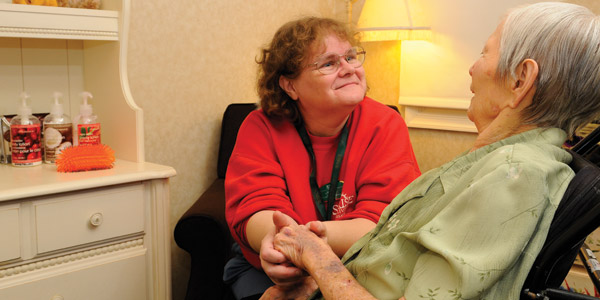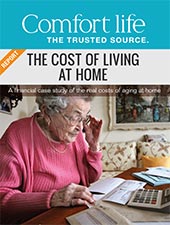Continuing care: What is it? Who is it for?
Continuing care (referred to in some contexts as synonymous with long-term care, as seen here), offers a perfect setting for a vulnerable senior in your life. These retirement homes allow your elderly loved ones to remove themselves from isolation and live in a safe and secure community that will meet their needs. Continuing care provides ill seniors with the opportunity to keep busy through programs and activities and to be social. Residents’ lives are filled with companionship! Indeed, long-term care offers a high degree of compassion and support that is simply unavailable at home. Photograph by Peter McCusker
Photograph by Peter McCuskerKathy Bruechle of The Briton House in Toronto, Ontario says, “I’m glad I’m here. I was too lonely in my own house. I have new friends here and I love the desserts! The staff are very friendly and are willing to do almost anything. Joan Dev of Erin Mills Lodge in Mississauga, Ontario agrees, “I can keep in touch with my local church and friends and still receive the care I need. Due to the kindness, help and encouragement from the staff, I have graduated form a wheelchair to a walker. I attend exercise classes and love to play bridge and bingo.”
Many of these communities let residents bring minor furnishings and personal items with them to give it a touch of home. In addition, plenty of continuing care organizations are sensitive to your cultural preferences, as well as your linguistic or religious situation.
Continuing care has a fairly large range of options. Where a standard rooms often house more than two residents, this option can be the least costly. “Preferred accommodations,” on the other hand, are typically private to semi-private rooms with lots of amenities, like climate control and private bathrooms with walk-in showers. These accommodations tend to be more costly. You may be eligible for government subsidies depending on income levels. (Be sure to check with the Federal government and your provincial government for all the details.)
Here are some helpful tips for continuing care…
- Make sure to talk about what your loved one is looking for in a retirement home. You should have this conversation while their mind is still sharp.
- Visit any potential retirement communities. Bringing a close friend or family member on this tour could be helpful. (You can dowload our Ultimate Retirement Tour Checklist ebook here to help you.)
- Ask as many questions as you can think of. You are about to make an important decision, so “stupid questions” are non-existent.
- Ask current residents about their experiences in a certain community.
- During your visit, you should ask to see all of the different types of rooms.
- Be sure to identify any hidden costs. In some cases, there you may have to pay more than a flat monthly rate.
- Plan early!
- Explore all possible options.
* * * * *
What do you like about continuing care retirement homes?
Related:
Long-term Care Retirement Homes
Aging Gracefully
Long-term Care vs. Alzheimer’s Care Homes
Things to Consider about Long Term Care


